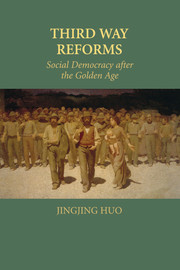Book contents
- Frontmatter
- Contents
- Tables and Figures
- Acknowledgments
- 1 Introduction
- 2 Theorizing the Third Way
- 3 Constraints on Action: Institutions and Ideas
- 4 Prelude to the Third Way: The Unemployment Problem and Earlier Responses
- 5 Expansion in Active Protection
- 6 Restructuring Passive Protection
- 7 Economic and Corporatist Contexts for the Third Way
- 8 Conclusion: Theories of Possibilities
- References
- Index
1 - Introduction
Published online by Cambridge University Press: 20 February 2010
- Frontmatter
- Contents
- Tables and Figures
- Acknowledgments
- 1 Introduction
- 2 Theorizing the Third Way
- 3 Constraints on Action: Institutions and Ideas
- 4 Prelude to the Third Way: The Unemployment Problem and Earlier Responses
- 5 Expansion in Active Protection
- 6 Restructuring Passive Protection
- 7 Economic and Corporatist Contexts for the Third Way
- 8 Conclusion: Theories of Possibilities
- References
- Index
Summary
Since the start of the New Labor government under Tony Blair, the phrase “third way” has come to symbolize the transformation of contemporary social democracy. The Blair revolution played an indispensable role in stimulating today's third way literature. Chronologically, it ushered in a new era in comparative research: No third way studies predated New Labour. Cross-sectionally, its impact reached many countries. The only two social democratic governments openly self-identifying as the “third way” were the Tony Blair and Gerhard Schröder administrations, but this notion has been utilized to evaluate center-left reforms across the industrialized world. This situation, however, creates some analytic dilemma. If the concept only describes governments that are Blair's contemporaries, the analysis suffers from post hoc theorization. What caused such a qualitative change in contemporary social democracy since 1997? After all, the timing of New Labour's rise was arbitrary. If the concept is extended backwards to describe center-left reforms well before New Labour, then does it really imply anything distinctly new? There had long existed a rich literature on social democratic transformation (Stephens 1979; Esping-Andersen 1980; Korpi 1983; Przeworski and Sprague 1986; Kitschelt 1994). Third way theories will become trivial if they are simply a new way of referring to well-known arguments about social democratic reforms.
By examining welfare and labor market reforms in nine countries, this book shows that not only can the third way account for social democratic transformation through a longer historical framework, but it also brings new insights to contemporary social democracy.
- Type
- Chapter
- Information
- Third Way ReformsSocial Democracy After the Golden Age, pp. 1 - 6Publisher: Cambridge University PressPrint publication year: 2009

